

How do you include OpenCL in a QT Creator project.
[C++/Qt] Performance de l'utilisation de QSharedPointer. Présentation Qt est un framework orienté objet écrit en C++ et permettant de faire des interfaces graphiques.
![[C++/Qt] Performance de l'utilisation de QSharedPointer](http://cdn.pearltrees.com/s/pic/th/performance-qsharedpointer-70663065)
Ce framework est utilisé par le projet KDE depuis ses débuts pour en faire un environnement de bureau très complet. Qt 4.7: All Classes. Anyone here ever used Cygwin for opengl/c programming? [Flat] - TribalWar Forums. Getdate. Software optimization resources. C++ and assembly. Windows, Linux, BSD, Mac OS X. See also my blog Contents Optimization manuals This series of five manuals describes everything you need to know about optimizing code for x86 and x86-64 family microprocessors, including optimization advices for C++ and assembly language, details about the microarchitecture and instruction timings of most Intel, AMD and VIA processors, and details about different compilers and calling conventions.
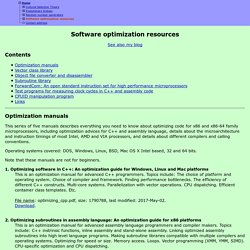
Operating systems covered: DOS, Windows, Linux, BSD, Mac OS X Intel based, 32 and 64 bits. Book.dvi - ch6-preview.pdf. Learn C++ Spatial stochastic simulation: Topics by WorldWideScience.org. Simulation. You need to know either Mathematica or Matlab (or both).
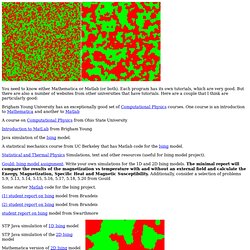
Each program has its own tutorials, which are very good. But there are also a number of websites from other universities that have tutorials. Here are a couple that I think are particularly good: Brigham Young University has an exceptionally good set of Computational Physics courses. One course is an introduction to Mathematica and another to Matlab. Selected Papers on Noise and Stochastic Processes. Game Engine Architecture: Jason Gregory, Jeff Lander, Matt Whiting: 9781568814131: Amazon.com. Real-Time Rendering Graphics books Page. Game Engine Architecture, by Jason Gregory, A.K.

Peters, July 2009. This book is about just that, how to make a professional-grade game rendering system, from soup to nuts. Eberly's two books are the previous notable works in this area, but are quite different than this new volume. While they focus almost exclusively on algorithms, this book attempts to cover the whole task of developing an engine: what to use for source control, dealing with memory management and in-game profiling, input devices, SIMD, and many other practical topics. There is also algorithmic coverage of rendering, animation, collision detection and physics, among other areas. GPU Gems 3: Chapter 7. Point-Based Visualization of Metaballs on a GPU. The tools, samples and other resources presented here are no longer under active development or support.
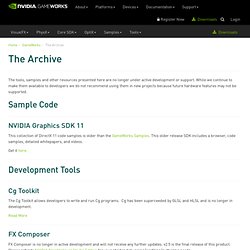
While we continue to make them available to developers we do not recommend using them in new projects because future hardware features may not be supported. Sample Code NVIDIA Graphics SDK 11 This collection of DirectX 11 code samples is older than the GameWorks Samples. This older release SDK includes a browser, code samples, detailed whitepapers, and videos. Graphics for Games; Game; Newcastle University. You are here: Newcastle University » Game » Masters Degree » Graphics for Games Skip to Content Newcastle University Game Graphics for Games.

NeHe Productions - Everything OpenGL. GPU Gems 3 - Chapter 37. Efficient Random Number Generation and Application Using CUDA. GPU Gems 3 is now available for free online!
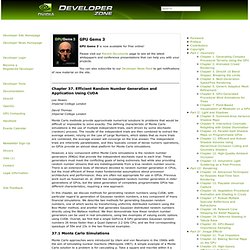
Please visit our Recent Documents page to see all the latest whitepapers and conference presentations that can help you with your projects. You can also subscribe to our Developer News Feed to get notifications of new material on the site. Chapter 37. Efficient Random Number Generation and Application Using CUDA Lee Howes Imperial College London David Thomas Imperial College London. Chapter 3 » www.scratchapixel.com. The other advantage of ray-tracing is that, by extending the idea of ray propagation, we can very easily simulates effects like reflection and refraction, both of which are handy in simulating glass materials or mirror surfaces.
GLSL Random Generator. Small noise / random function in GLSL: varying vec3 v; float rand(vec2 n) { return 0.5 + 0.5 * fract(sin(dot(n.xy, vec2(12.9898, 78.233)))* 43758.5453); } void main(void) { float x = rand(v.xz); gl_FragColor = vec4(x, x, x, 1.0); }
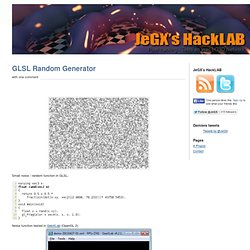
Shader - Random / noise functions for GLSL. Untitled. Index of /me/courses. Bruits et nombres aléatoires cohérents. Bonjour à tous !
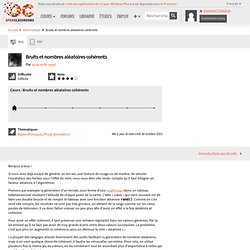
Si vous avez déjà essayé de générer un terrain, une texture de nuage ou de marbre, de simuler l'oscillation des herbes sous l'effet du vent, vous vous êtes vite rendu compte qu'il faut intégrer un facteur aléatoire à l'algorithme. Prenons par exemple la génération d'un terrain, sous forme d'une heightmap (donc un tableau bidimensionnel stockant l'altitude de chaque point de la carte). L'idée « naïve » qui vient souvent est de faire une double boucle et de remplir le tableau avec une fonction aléatoire rand(). Comme on s'en rend vite compte, les résultats ne sont pas très glorieux, on obtient de la neige comme sur les vieux postes de télévision. Il va donc falloir creuser un peu plus afin d'avoir un effet à la fois aléatoire et cohérent. Pour avoir un effet cohérent, il faut préserver une certaine régularité dans les valeurs générées.
Voici quelques exemples expliqués dans ce tutoriel : Simulating Particle Effects using OpenGL. Particle Effect In this article I will demonstrate one possible way to implement a particle effect in C++ using OpenGL to render the effect. Tutorials for modern OpenGL (3.3+) Tutorial 1 : Opening a window. Welcome to the first tutorial ! Before jumping into OpenGL, you will first learn how to build the code that goes with each tutorial, how to run it, and most importantly, how to play with the code yourself. No special prerequisite is needed to follow these tutorials. Comparison of Nvidia graphics processing units. This page contains general information about Nvidia's GPUs and videocards based on official Nvidia specifications. DirectX version note[edit] DirectX version indicates which Direct3D graphics acceleration operations the card supports.
OpenGL version note[edit] OpenGL version indicates which graphics acceleration operations the card supports. Field explanations[edit] CPU-to-GPU data transfers exceed 15GB/s using APU zero copy path. At the AMD Fusion Developer Summit (AFDS), AMD introduced the AMD A-Series processors, formerly known as the “Sabine” platform and “Llano” APU. The AMD A-Series APU is a capable GPU compute device, the A8-3850 with Radeon™ HD 6550D Graphics is capable of up to480 GFLOPS of performance. In order to fully benefit from this performance, it is essential to be able to transfer data efficiently between the host CPU and the GPU.
In this blog I discuss the zero copy data transfer path that has been introduced to support the tighter coupling between CPU and GPU memory afforded by the APU architecture. As you may be aware, in the AMD A-Series APU the CPU and GPU share a common DDR3 memory, partitioning the memory between the CPU and the GPU. [Qt] Problème de linkage avec glew. Note. GPU Gems 3 - Chapter 37. Efficient Random Number Generation and Application Using CUDA. Quick and Easy GPU Random Numbers in D3D11 – Nathan Reed's coding blog. In games and graphics one often needs to generate pseudorandom numbers. Needless to say, PRNGs are an extremely well-researched topic; however, the majority of the literature focuses on applications with very exacting quality requirements: cryptography, high-dimensional Monte Carlo simulations, and suchlike.
These PRNGs tend to have hundreds of bytes of state and take hundreds of instructions to update. That’s way overkill for many more modest purposes—if you just want to do a little random sampling in a game context, you can probably get away with much less. Computer Graphics Programming Techniques and Ray Tracing Tutorials » www.scratchapixel.com. Recommended books and programming websites.
FENS - Federation of European Neurosciences. Une introduction à CUDA. Une introduction à CUDA. Très simplement, un kernel est une fonction exécutée sur le GPU. OptiX - Moteur d’accélération d’applications. La 3D avec le module OpenGL de Qt. La 3D avec le module OpenGL de Qt. Les sources du chapitre sont disponibles dans le fichier zip. L'application permet de changer dynamiquement de mode de transfert de données, d'afficher ou non les textures, de modifier la limitation du FPS.
Il existe plusieurs méthodes pour transférer les données entre la mémoire centrale (RAM) et la mémoire du processeur graphique. Unity (moteur de jeu) Un article de Wikipédia, l'encyclopédie libre. Pour les articles homonymes, voir Unity. Unity est un logiciel 3D temps réel et multimédia ainsi qu'un moteur 3D/2D et physique utilisé pour la création de jeux en réseau, d'animation en temps réel, de contenu interactif comportant de l'audio, de la vidéo et des objets 3D/2D.
Il a la particularité de proposer une licence gratuite. La version 4.0, sortie en novembre 2012, intègre le développement de jeux compatibles avec Linux[3],[4]. TC Particles - Making special effects special again. Posts 402 tcparticles.tinycubestudio.com TC Particles is a DirectX 11 powered particle engine. It brings you the power to interactively simulate hundreds of thousands, if not millions, of particles.
Take a look at the website for more infoInteractivity TC Particles comes with a suite of forces (ranging from simple forces to complex turbulence forces) and colliders (ranging from boxes and spheres, to entire terrains) to better integrate special effects with your scene. Whether it’s a simple smoke trail, or a complex magic effect, TC Particles will make it more interactive – and beautiful. The workflow has been optimized to give you all the power you need, without added complexity. C++ -> C#: What You Need to Know to Move from C++ to C#
OpenCL - Kronos_page. OpenCL tuto_partial but good.